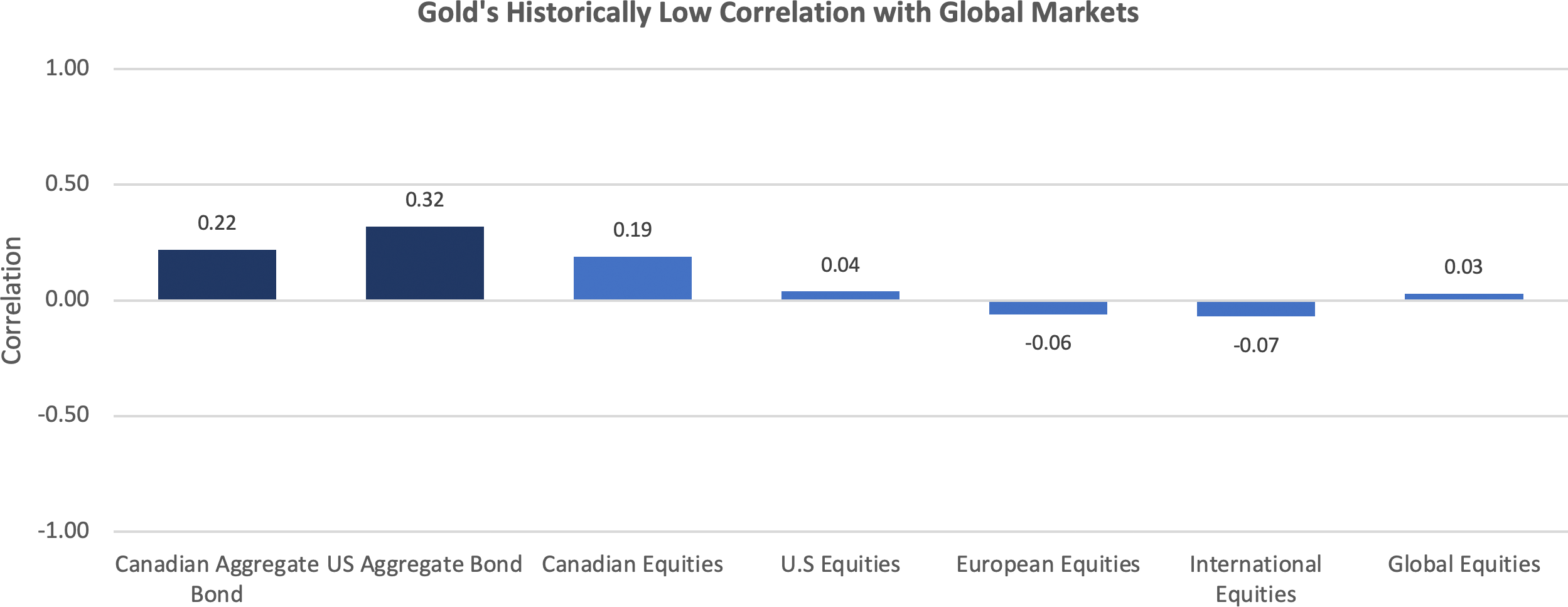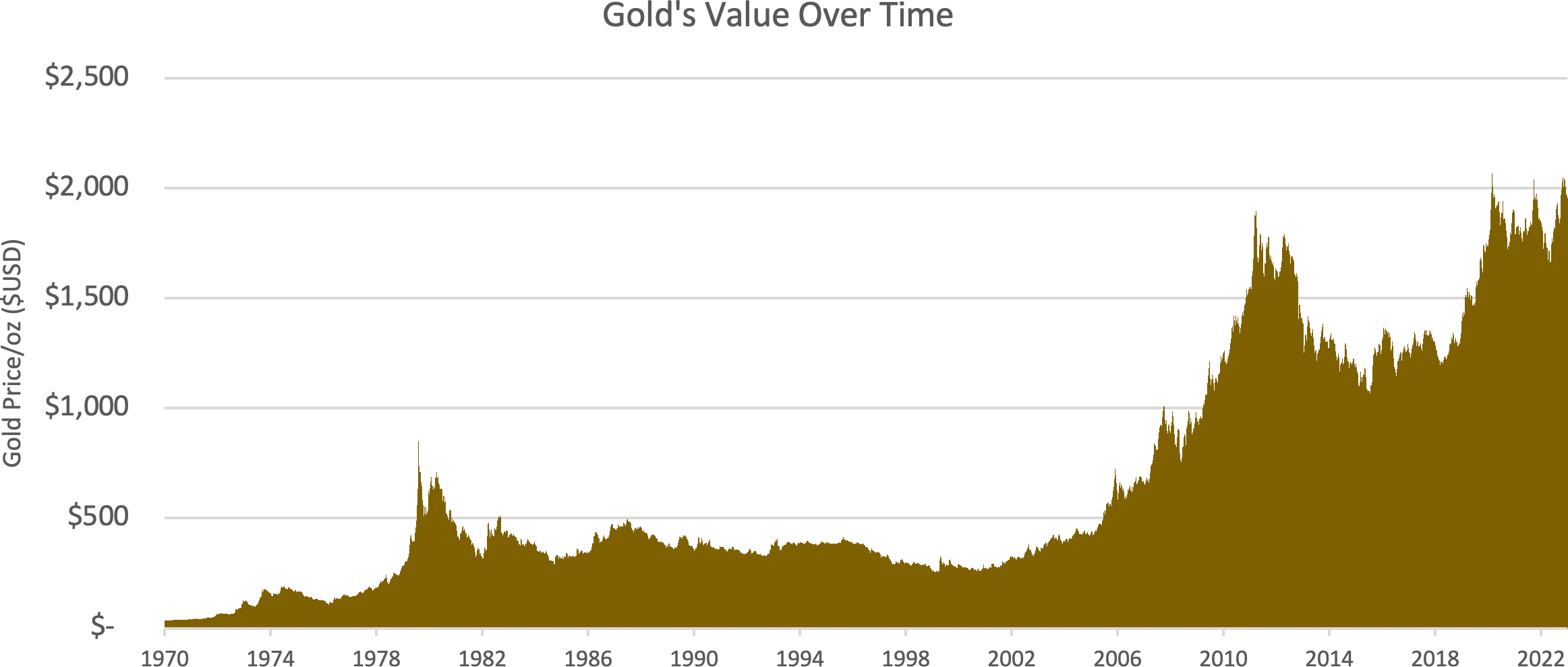June 30, 2023
The Gold Standard – Reliability in Times of Uncertainty

We tend to get enamoured with anything “new and exciting,” and the general affinity toward trends such as cryptocurrencies have essentially reached cult status. While bitcoin isn’t necessarily new and has definitely proven itself as a more enduring asset than many had predicted, its true investment merit is still speculative and remains to be seen. Gold on the other hand, has been used as a store of value and medium of exchange for centuries, and more increasingly as an effective portfolio diversifier. It may not be as exciting and fast moving as the price of cryptocurrencies, but it serves as a great investment tool, especially in this highly volatile, negative real rate environment.
Diversification that works
We frequently hear about the benefits of portfolio diversification, but sometimes it doesn’t always work when we need it to. This is because many asset classes are increasingly correlated – as market uncertainty and volatility rises, correlation tends to also increase. As a result, investors are left without portfolio diversification when they need it the most, as we saw with Fixed Income and Equities in 2022.
That’s where gold is different. Gold has historically exhibited a low to negative correlation to major asset classes and has proven to be a genuine diversifier in times of greater market volatility, resulting in lower portfolio volatility and preserved purchasing power.

Source: Morningstar Research Inc., data from January 1, 2001 to May 31, 2023. Correlations are calculated from monthly returns in Base Currency. Asset classes represented by the following indices — Canadian Aggregate Bond: FTSE Canada Universe Bond Index, US Aggregate Bonds: Bloomberg Barclays US Aggregate Bond Index, Global Equities: MSCI AC World Index; U.S. Equities: S&P 500; Canadian Equities: S&P/TSX Composite Index, European Equities: MSCI Europe Index; International Equities: MSCI EAFE Index.
Gold isn’t just a tactical asset for times of crisis. As a tangible asset that’s been around for centuries, gold holds up as a historical store of value without the counterparty risk of stocks and bonds. In fact, the price of gold has increased from $43.63/oz in 1971 to a high of $2,074.88/oz in 2020.

Source: Morningstar Research Inc., as at June 16, 2023.
Gold’s role in a portfolio
When properly allocated, gold has an important role to play in both enhancing returns and reducing risk. Overall, analysis suggests that adding gold to a typical 60/40 portfolio has resulted in tangible improvement to absolute and risk-adjusted returns on a long-term basis, while protecting capital in periods of elevated market volatility.

Source: Morningstar Research Inc., from Mar 1, 1999 to May 31, 2023. Performance in CAD. Notes: Equity allocation comprised of MSCI World Index CAD. Fixed income allocation comprised of Bloomberg Barclays Global Aggregate Bond Index (CAD-Hedged). Gold allocation comprised of LBMA Gold Price USD. 1Covid-19 Drawdown from Feb 19, 2020 to Mar 23, 2020. 2Global Financial Crisis from Aug 11, 2008 to Mar 9, 2009. 32002 Recession from Mar 19, 2002 to Jul 23, 2002.
Cost-effective and convenient gold exposure
The gold market is large, global and highly liquid, but owning the physical asset can be complex and inconvenient. This is where physical gold-backed ETFs can provide easy access to the properties and security of physical gold ownership, without the complexity and inconvenience of arranging for storage and insurance separately.
CI Global Asset Management’s CI Gold Bullion Fund (TSX: VALT, VALT.U) provides exposure to the physical gold bullion market in London through an ETF. The ETF is the lowest fee1 gold bullion fund in Canada with a management fee of 0.155%, giving investors a convenient and cost-effective way to own physical gold.
Golden opportunity
While gold, one of the world’s oldest currencies, might not be as exciting as cryptocurrencies, it has a proven history of protecting against negative real rates and currency debasement, while also showcasing a long track record of providing investors with diversification and better portfolio risk-adjusted returns.
Gold is not only a useful long-term strategic component for portfolios, but one that is increasingly relevant in this high inflation, highly volatile environment.
1CI Global Asset Management as at June 15, 2023.
About the Author
As Vice-President, Head of ETF Strategy, Nirujan’s primary responsibility includes working with the various departments within CI GAM to set and execute the ETF Sales Strategy and help promote the growth of the ETF business. Nirujan’s responsibilities also includes overseeing the ETF Sales Support team where he works alongside the sales team in assisting investors and advisors on ETF education and support. Nirujan brings a wealth of ETF knowledge, including ETF product management, indexing, factor research, ETF portfolio development, and has been involved in the launch of many ETFs in the Canadian marketplace. Prior to joining CI GAM, Nirujan held progressively senior roles with global asset managers Invesco and Horizons ETFs, where responsibilities included product management, product development and sales strategy in both the Canadian and U.S market. Nirujan holds a Bachelor of Commerce (Finance and Accounting) from Ryerson University and is a CFA Charterholder.
IMPORTANT DISCLAIMERS
Commissions, management fees and expenses all may be associated with an investment in exchange-traded funds (ETFs). You will usually pay brokerage fees to your dealer if you purchase or sell units of an ETF on recognized Canadian exchanges. If the units are purchased or sold on these Canadian exchanges, investors may pay more than the current net asset value when buying units of the ETF and may receive less than the current net asset value when selling them. Please read the prospectus before investing. Important information about an exchange-traded fund is contained in its prospectus. The indicated rates of return are the historical annual compounded total returns net of fees and expenses payable by the fund (except for figures of one year or less, which are simple total returns) including changes in security value and reinvestment of all dividends/distributions and do not take into account sales, redemption, distribution or optional charges or income taxes payable by any securityholder that would have reduced returns. ETFs are not guaranteed; their values change frequently, and past performance may not be repeated.
Certain statements in this document are forward-looking. Forward-looking statements (“FLS”) are statements that are predictive in nature, depend upon or refer to future events or conditions, or that include words such as “may,” “will,” “should,” “could,” “expect,” “anticipate,” “intend,” “plan,” “believe,” or “estimate,” or other similar expressions. Statements that look forward in time or include anything other than historical information are subject to risks and uncertainties, and actual results, actions or events could differ materially from those set forth in the FLS. FLS are not guarantees of future performance and are by their nature based on numerous assumptions. Although the FLS contained herein are based upon what CI Investments Inc. and the portfolio manager believe to be reasonable assumptions, neither CI Investments Inc. nor the portfolio manager can assure that actual results will be consistent with these FLS. The reader is cautioned to consider the FLS carefully and not to place undue reliance on FLS. Unless required by applicable law, it is not undertaken, and specifically disclaimed that there is any intention or obligation to update or revise FLS, whether as a result of new information, future events or otherwise.
This document is provided as a general source of information and should not be considered personal, legal, accounting, tax or investment advice, or construed as an endorsement or recommendation of any entity or security discussed. Every effort has been made to ensure that the material contained in this document is accurate at the time of publication. Market conditions may change which may impact the information contained in this document. All charts and illustrations in this document are for illustrative purposes only. They are not intended to predict or project investment results. Individuals should seek the advice of professionals, as appropriate, regarding any particular investment. Investors should consult their professional advisors prior to implementing any changes to their investment strategies.
Certain statements contained in this communication are based in whole or in part on information provided by third parties and CI Investments Inc. has taken reasonable steps to ensure their accuracy. Market conditions may change which may impact the information contained in this document.
© 2023 Morningstar Research Inc. All Rights Reserved. The information contained herein: (1) is proprietary to Morningstar and/or its content providers; (2) may not be copied or distributed; and (3) is not warranted to be accurate, complete or timely. Neither Morningstar nor its content providers are responsible for any damages or losses arising from any use of this information. Past performance is no guarantee of future results.
CI Global Asset Management is a registered business name of CI Investments Inc., a wholly-owned subsidiary of CI Financial Corp. (TSX: CIX).
